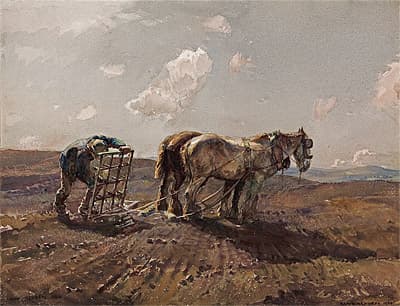Hans
HEYSEN
Germany
1877
–
Australia
1968
Australia from 1884; Europe, England 1899-1903
The toilers
1920
watercolour on paper
Frame
73.0 (h)
x 86.0 (w)
x 5.0 (d)
cm
Bequest of the artist, 1969, Art Gallery of South Australia
A most spectacular watercolour from this period is The Toilers, which was awarded the 1920 Wynne Prize. It was a favourite of the artist’s and remained in his possession until his death, to be bequeathed to the Art Gallery of South Australia. It was inspired by what the artist saw on an early morning visit to Hahndorf to collect mail.[1] The ploughman had lifted one of the horse-drawn harrows and was cleaning earth from the tines of the geometric implement, his back outlined by light; the two draught horses, Pollv and Jack, who were favourite subjects for Heysen’s studies, pause momentarily from their toil of hauling.[2] The curved form of the bending worker rhymes exactly with his horses: man and beasts are in harmony. The centralised ploughman and horses, shown in full-length profile as shadowed silhouettes on brown earth, have the nobility of a bronze sculptural relief. The powerful motif recalls Jean-Francois Millet’s heroic and monumental peasants.[3] The Barbizon School—of which Millet was a key exponent—was the most significant manifestation of mid-nineteenth-century Naturalism in France and exerted a profound influence on Hevsen. The school’s Dutch followers were also significant for Hevsen, who noted during his travels in Europe in 1900: ‘the modern Dutch School of painting impressed me considerably—I like their simplicity and truth of nature and solid techniques. Jacob Mans is m favourite and his work has impressed me most of any landscape painter.’[4] Heysen’s Dutch farm worker gathering wood had depicted rural labour at Laren in Holland in 1901, but the theme was more fully realised at Hahndorf in The Toilers.
“The ploughing pictures you refer to were in a sense a new departure in introducing the human element, although the main theme still remains ‘light’. The old chap with ‘Polly and Jack’ munching their well-earned late breakfast, happened on our own little plot last autumn. I came upon them at the moment when the animals were still sweating and steaming from their graft, and I had to work hard to get my impression of the form and general construction before the truth of the moment vanished, to be replaced by another truth.”[5]
© Art Gallery of South Australia, Adelaide, 2008
Andrews, Hans Heysen, exhibition book, Art Gallery of South Australia, Adelaide, 2008, p 64
[1] Dridan, text accompanying plate 11
[2] Polly and Jack belong to ‘old Kramm’, who came in regularly to do the ploughing at The Cedars
[3] Heysen owned a drawing by Millet, Les Lavandières, charcoal drawing, c 1875 (see lot 131 Leonard Joel, ‘Hans Heysen Collection catalogue’, Leonard Joel Auction, Melbourne, 1970). He probably bought the work during a trip to Europe in 1934; it had once belonged to James Staats Forbes (1823–1904), an important collector of Barbizon art
[4] Heysen letter to Archibald Collins, 18 November 1900 (quoted in North, p 16)
[5] Heysen letter to Lionel Lindsay, 8 December 1918 (reproduced in Lindsay, pp 15-16)
